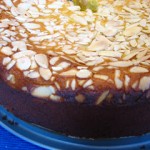I have a number of things in common with the Greensteins in The Tin Horse. Like Barbara and Elaine, I’m into modern dance. Like Elaine, I’ve always been a reader. One thing I didn’t expect to share, however, was Mama’s special apple cake. I like to cook, but I do not bake. In that, I’m like my mom, who went for months not realizing that her oven didn’t work.
Then, last year, my mom’s 90th birthday fell during Passover. My brothers and I were throwing a party, and I couldn’t find anyone in Milwaukee from whom I could buy a Passover cake (which can’t have regular flour or leavening). I tried a caterer and kosher delis. Cost was irrelevant. But no luck. As someone who does not bake, the last thing I wanted to experiment with was my mother’s cake. I considered offering guests a plate of festive Passover macaroons, the kind you buy in cans. What kind of daughter would do that for her mother’s 90th birthday? Finally, in desperation, I found this recipe by Nigella Lawson. I learned what a springform pan was, bought one from Amazon, then put socks inside it, and packed it in my suitcase. The cake was such a hit at my mom’s party that I made it for my seder Monday.
If I can make this cake, anyone can.
A few notes: Nigella recommends Braeburn apples, but I originally found her recipe someplace else (the NY Times) and it suggested Granny Smiths. I prefer the Granny Smiths. And “superfine sugar” is also called caster sugar or baking sugar.
Damp Apple and Almond Cake
Nigella Lawson
Ingredients
3 apples eating apples, such as Braeburns
1 tablespoon lemon juice
2 teaspoons sugar
8 eggs
1 3/4 quarters cup superfine sugar
3 1/4 cups ground almonds
1 tablespoon lemon juice
1/2 cup flaked almonds
1 teaspoon confectioners’ sugar
Preparation
Peel, core and chop the apples roughly. Put them in a saucepan with one T. lemon juice and sugar, and bring the pan to a boil over a medium heat. You may need a wee bit of water to keep things moist. Cover the pan and cook over low heat for about 10 minutes or until you can mash the apple to a rough puree with a wooden spoon or fork. (You should have about one heaped cup of puree.) Leave to get cool.
Preheat the oven to 350°F; and oil a 10” springform pan with almond oil or a flavourless vegetable oil and line the bottom with parchment paper.
Put the cooled puree in the processor with the eggs, ground almonds, superfine sugar and a tablespoonful — or generous squeeze — of lemon juice and blitz to a puree. Pour and scrape, with a rubber spatula for ease, into the prepared pan, sprinkle the flaked almonds on top and bake for about 45 minutes. It’s worth checking after 35 minutes, as ovens do vary, and you might well find it’s cooked earlier — or indeed you may need to give it a few minutes longer.
Put on a wire rack to cool slightly, then remove the sides of the pan. This cake is best served slightly warm, though still good cold. As you bring it to the table, push a teaspoon of confectioners’ sugar through a fine sieve to give a light dusting.
Serves 12 (or serves about 25, if they have appetites like my mom’s 90-year-old cronies)


